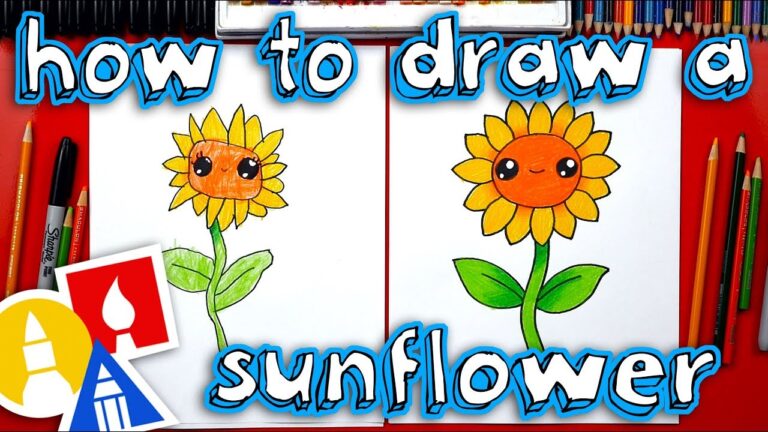[ad_1]
1. Gather your materials:
- Paper (drawing paper or sketchbook)
- Pencil (HB or similar for sketching, 2B or darker for outlining)
- Eraser (kneaded eraser is helpful)
- Colored pencils, crayons, markers, or paint (yellows, browns, greens) – optional
- Ruler (optional, for guidelines)
2. Initial Sketching:
- Circle for the Center: Lightly draw a circle. This will be the sunflower’s center. The size of this circle will determine the size of your sunflower.
- Larger Circle for Petals: Draw a larger, lighter circle around the center circle. This larger circle will serve as a guide for the placement of the petals.
- Stem: Draw a line extending downwards from the center circle. This will be the stem of the sunflower. The length and angle are up to you.
- Leaves: Add a few leaf shapes along the stem. These can be simple oval or teardrop shapes for now.
3. Petal Construction:
- Petal Guidelines: Inside the larger circle, start sketching the petals. Think of them radiating outward from the center circle. Start with some basic petal shapes distributed evenly around the center. They should extend outwards toward the outer circle guideline.
- Petal Shapes: Sunflower petals are typically elongated ovals with slightly pointed ends. Don’t make them all perfectly uniform; variations will make the sunflower look more natural. Vary the shapes and sizes slightly. Some petals can overlap others.
- Layering: Add a second layer of petals behind the first layer to give depth. These petals will be partially hidden and shorter than the front petals.
4. Center Detail:
- Refine the Center Circle: Erase the initial guide lines inside the center circle.
- Seed Pattern: Inside the center, draw a spiral pattern to represent the seeds. Start with a small spiral in the center and gradually expand outwards. This doesn’t need to be perfect.
- Texture: Add small dots or circles to the spiral pattern to suggest individual seeds. Vary the size and spacing of the dots for a more organic look.
5. Stem and Leaves:
- Stem Thickness: Add thickness to the stem line.
- Leaf Shapes: Refine the shapes of the leaves. Sunflower leaves are generally ovate or heart-shaped with serrated (toothed) edges.
- Veins: Draw a central vein down each leaf and add smaller veins branching out from it.
6. Outlining (Optional):
- Outline Key Areas: Use a darker pencil, pen, or marker to outline the main shapes of the sunflower: the petals, center, stem, and leaves.
- Vary Line Weight: Vary the thickness of the outline to add depth and visual interest. Thicker lines can indicate areas in shadow or closer to the viewer.
7. Erasing Guidelines:
- Erase all the remaining guidelines (circles, initial petal sketches).
8. Shading and Coloring (Optional):
- Petals: Use yellow colored pencils, crayons, markers, or paint to color the petals. Vary the shades of yellow to add depth. Add hints of orange or brown near the base of the petals where they connect to the center.
- Center: Use brown or dark brown to color the center. Add darker shades around the edges of the seed pattern to create shadows.
- Stem and Leaves: Use green to color the stem and leaves. Add darker greens for shadows and lighter greens for highlights.
- Shading: Use shading to create depth and dimension. Add shadows to the undersides of the petals, along the edges of the center, and on the stem and leaves. Consider the direction of the light source.
Tips for a Realistic Sunflower:
- Observation: Look at real sunflowers or photographs of sunflowers to understand their structure and details.
- Imperfection: Don’t strive for perfect symmetry. Natural objects are often asymmetrical, so embrace imperfections.
- Texture: Use different pencil strokes or coloring techniques to create texture.
- Light and Shadow: Pay attention to how light falls on the sunflower and use shading to create a sense of depth.
- Practice: The more you practice drawing sunflowers, the better you will become.
Variations:
- Different Angles: Draw sunflowers from different angles (side view, back view).
- Buds: Add sunflower buds to your drawing.
- Multiple Sunflowers: Draw a field of sunflowers.
- Wilting Sunflower: Draw a sunflower that is wilting or drooping.
By following these steps, you can create a drawing of a sunflower. Experiment with different techniques and materials to find what works best for you.
[ad_2]

